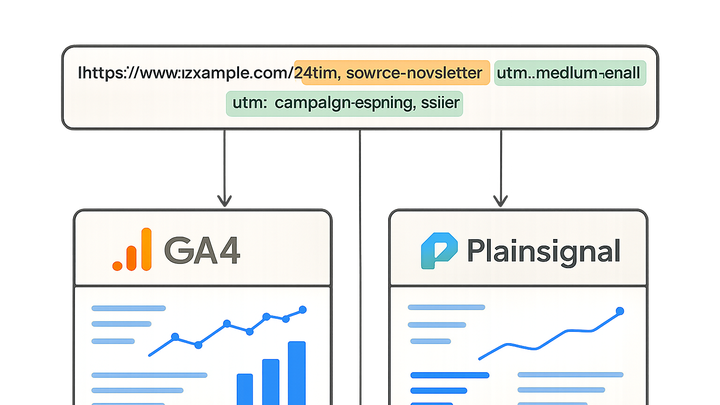Published on 2025-06-28T05:27:42Z
What is Campaign Tagging? Examples for Campaign Tagging.
Campaign tagging is the practice of appending query parameters (commonly UTM parameters) to URLs in marketing assets to identify and analyze the performance of different campaigns across channels. By adding standardized parameters such as utm_source, utm_medium, utm_campaign, utm_term, and utm_content, analytics platforms like Google Analytics 4 (GA4) and PlainSignal can automatically attribute incoming traffic and conversions to the correct marketing effort. This enables marketers to compare channel effectiveness, optimize budgets, and measure ROI with precision. Campaign tagging can be done manually using URL builders, automatically through platform features, or via custom scripts in cookie-free analytics solutions. Properly implemented tagging ensures consistent data, more accurate insights, and better decision-making in digital marketing strategies.
Campaign tagging
Method of appending UTM parameters to URLs for tracking marketing campaign performance across channels.
Understanding Campaign Tagging
Campaign tagging uses query parameters appended to URLs to pass information about the traffic source, medium, and campaign name into analytics systems. These parameters allow platforms to categorize and filter traffic, making it possible to distinguish between different marketing efforts. Standard UTM parameters include utm_source (origin of traffic), utm_medium (marketing channel), and utm_campaign (campaign identifier), with optional utm_term and utm_content for paid search keywords and ad variations.
-
Core utm parameters
The three essential parameters that must be included in most tagged URLs.
-
Utm_source
Identifies the referrer (e.g., ‘google’, ‘newsletter’).
-
Utm_medium
Specifies the marketing medium (e.g., ‘email’, ‘cpc’, ‘social’).
-
Utm_campaign
Names the specific campaign or promotion (e.g., ‘spring_sale’).
-
-
Additional utm parameters
Optional parameters for more granular analysis.
-
Utm_term
Tracks paid search keywords or targeted terms.
-
Utm_content
Differentiates similar content or A/B test variations.
-
Importance of Campaign Tagging
Without proper tagging, traffic appears as ‘direct’ or lumps multiple channels together, making it impossible to measure the true impact of individual campaigns. Tagged campaigns provide clarity on which channels drive the most traffic, which creative assets perform best, and how different segments convert.
-
Accurate source attribution
Ensures each visit is credited to the correct marketing channel.
-
Performance analysis
Allows comparison of engagement and conversion metrics across campaigns.
-
Budget optimization
Helps allocate ad spend to top-performing channels.
Implementing Campaign Tagging
Tagging can be done manually, via platform auto-tagging, or through custom scripts. Choose the method that best aligns with your analytics setup and team workflow.
-
Manual tagging via url builder
Use tools like Google’s Campaign URL Builder to fill in UTM fields and generate tagged links for emails, social posts, or ads.
-
Automatic tagging in GA4
Enable auto-tagging in Google Ads to automatically append GCLID and map it to UTM parameters in GA4 for Google Ads campaigns.
-
Tracking with PlainSignal
Embed PlainSignal’s cookie-free analytics snippet to automatically capture UTM parameters without requiring cookies.
-
Insert snippet
Place the PlainSignal
<link>and<script>tags in the<head>section of your HTML. -
Automatic utm capture
PlainSignal reads any UTM parameters on page load and includes them in reports.
-
Examples of Campaign Tagging in Action
Below are practical examples showing how to implement and use campaign tagging with both PlainSignal and Google Analytics 4.
-
PlainSignal code example
PlainSignal uses a cookie-free snippet that automatically captures UTM parameters:
<link rel='preconnect' href='//eu.plainsignal.com/' crossorigin /> <script defer data-do='yourwebsitedomain.com' data-id='0GQV1xmtzQQ' data-api='//eu.plainsignal.com' src='//cdn.plainsignal.com/plainsignal-min.js'></script> -
GA4 utm link example
A typical UTM-tagged link captured by GA4:
<a href='https://example.com/?utm_source=newsletter&utm_medium=email&utm_campaign=spring_sale'>View Spring Sale</a>
Best Practices and Common Pitfalls
Following consistent rules and testing your tagged URLs can prevent data discrepancies and ensure high-quality analytics.
-
Maintain consistent naming
Use lowercase, hyphens or underscores, and avoid spaces to ensure uniform reporting.
-
Avoid parameter duplication
Never mix auto-tagging and manual tagging on the same link to prevent overwriting data.
-
Test and validate urls
Click through each tagged link and verify parameters appear correctly in your analytics tool.
